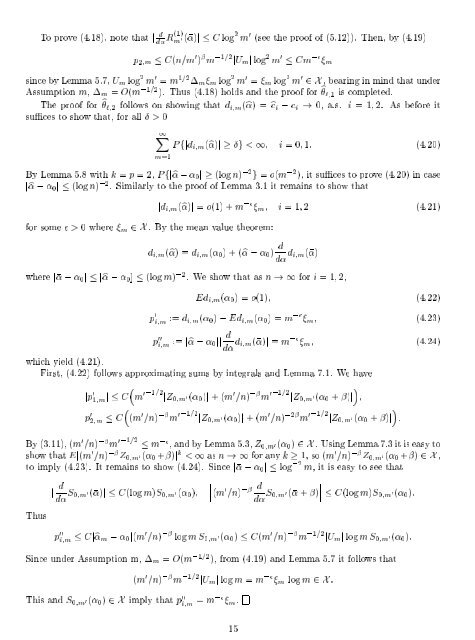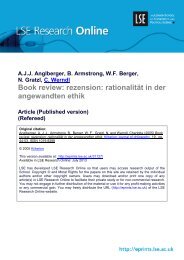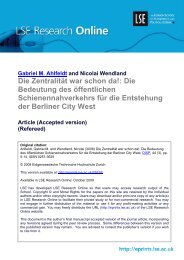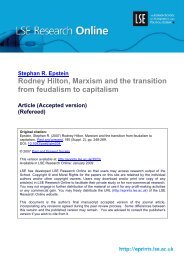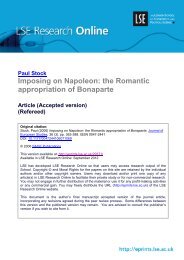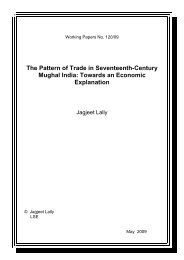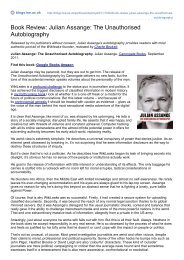Download (535Kb) - LSE Research Online - London School of ...
Download (535Kb) - LSE Research Online - London School of ...
Download (535Kb) - LSE Research Online - London School of ...
Create successful ePaper yourself
Turn your PDF publications into a flip-book with our unique Google optimized e-Paper software.
To prove (4.18), note that j d<br />
d R(1)<br />
m 0 ( )j C log2 m 0 (see the pro<strong>of</strong> <strong>of</strong> (5.12)). Then, by (4.19)<br />
p2m C(n=m 0 ) m ;1=2 jUmj log 2 m 0 Cm ; m<br />
since by Lemma 5.7, Um log 2 m 0 = m 1=2 m m log 2 m 0 = m log 2 m 0 2X, bearing in mind that under<br />
Assumption m, m = O(m ;1=2 ). Thus (4.18) holds and the pro<strong>of</strong> for b `1 is completed.<br />
The pro<strong>of</strong> for b `2 follows on showing that dim(b) = bci ; ci ! 0, a.s. i = 1 2. As before it<br />
su ces to show that, for all >0<br />
1X<br />
m=1<br />
P fjdim(b)j g < 1 i =0 1: (4.20)<br />
By Lemma 5.8 with k = p =2,P fjb ; 0j (log n) ;2 g = o(m ;2 ) it su ces to prove (4.20) in case<br />
jb ; 0j (log n) ;2 . Similarly to the pro<strong>of</strong> <strong>of</strong> Lemma 3.1 it remains to show that<br />
for some >0where m 2X. By the mean value theorem:<br />
jdim(b)j = o(1) + m ; m i =1 2 (4.21)<br />
dim(b) =dim( 0)+(b ; 0) d<br />
d dim( )<br />
where j ; 0j jb ; 0] (log m) ;2 . We showthatasn !1for i =1 2,<br />
Edim( 0) =o(1) (4.22)<br />
p 0 im := dim( 0) ; Edim( 0) =m ; m (4.23)<br />
p 00<br />
im := jb ; 0jj d<br />
d dim( )j = m ; m (4.24)<br />
which yield (4.21).<br />
First, (4.22) follows approximating sums by integrals and Lemma 7.1. We have<br />
jp 0 1m j C m0;1=2 jZ0m 0( 0)j +(m 0 =n) ; m 0;1=2 jZ0m 0( 0 + )j <br />
p 0 2m C (m 0 =n) ; m 0;1=2 jZ0m 0( 0)j +(m 0 =n) ;2 m 0;1=2 jZ0m 0( 0 + )j :<br />
By (3.11), (m 0 =n) ; m 0;1=2 m ; ,andby Lemma 5.3, Z0m 0( 0) 2X. Using Lemma 7.3 it is easy to<br />
show that Ej(m 0 =n) ; Z0m 0( 0 + )j k < 1 as n !1for any k 1, so (m 0 =n) ; Z0m 0( 0 + ) 2X,<br />
to imply (4.23). It remains to show (4.24). Since j ; 0j log ;2 m, it is easy to see that<br />
Thus<br />
j d<br />
d S0m0( )j C(log m)S0m0( 0) (m 0 ; d<br />
=n)<br />
d S0m0( + ) C(log m)S0m0( 0):<br />
p 00<br />
im Cjbm ; 0j(m 0 =n) ; log mS0m 0( 0) C(m 0 =n) ; m ;1=2 jUmj log mS0m 0( 0):<br />
Since under Assumption m, m = O(m ;1=2 ), from (4.19) and Lemma 5.7 it follows that<br />
(m 0 =n) ; m ;1=2 jUmj log m = m ; m log m 2X:<br />
This and S0m 0( 0) 2X imply that p 00<br />
im = m ; m.<br />
15


